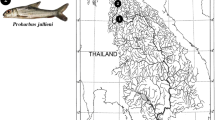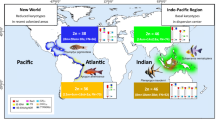Abstract
Evidence suggesting that the goldfish and the carp of the family Cyprinidae are tetraploid species in relation to other members of the same family were presented. The two barb species, Barbus tetrazona and Barbus jasciatus, were chosen as representatives of diploid members of the family Cyprinidae. These barbs had the diploid chromosome number of 50 and 52 and the DNA value 20–22% that of placental mammals, while the goldfish (Carassius auratus) and the carp (Cyprinus carpio) had the diploid chromosome number of about 104 and the DNA value 50–52% that of placental mammals.
Similar content being viewed by others
References
Atkin, N. B., G. Mattinson, W. Beçak, and S. Ohno: The comparative DNA content of 19 species of placental mammals, reptiles, and birds. Chromosoma (Berl.) 17, 1–10 (1965).
Beçak, M. L., W. Beçak, and M. N. Rabello: Cytological evidence of constant tetraploidy in the bisexual South American frog, Odontophrynus americanus. Chromosoma (Berl.) 19, 188–193 (1966).
Chen, T.: Comparative karyology of selected deepsea and shallow water teleost fishes. Ph. D. dissertation, Biology, Yale University 1967.
Deeley, E. M.: An integrating microdensitometer for biological cells. J. sci. Instrum. 32, 263–267 (1955).
Makino, S.: The chromosomes of the carp, Cyprinus carpio, including those of some related species of Cyprinidae for comparison. Cytologia (Tokyo) 9, 430–440 (1939).
Matsui, Y.: Genetical studies on goldfish of Japan. J. Imperial Fisheries Inst. (Japan) 30, 1–96 (1934).
Nogusa, S.: A comparative study of the chromosomes in fishes with particular considerations on taxonomy and evolution. Mem. Hyogo Univ. Agric. 3, 1–62 (1960).
Ohno, S., and N. B. Atkin: Comparative DNA values and chromosome complements of eight species of fishes. Chromosoma (Berl.) 18, 455–466 (1966).
Ojima, Y., S. Hitosumachi, and S. Makino: Cytogenetic studies in lower vertebrates. I. A preliminary report on the chromosomes of the funa (Carassius auratus) and the goldfish (a revised study). Proc. Japan Acad. 24, 62–66 (1966).
Post, A.: Vergleichende Untersuchungen der Chromosomenzahlen bei Süßwasser-Teleosteern. Z. Zool., Syst. Evolut.-forsch. 3, 47–93 (1965).
Rothfels, K., E. Sexsmith, M. Heimburger, and M. O. Krause: Chromosome size and DNA content of species of Anemone and related genera (Ranunculaceae). Chromosoma (Berl.) 20, 54–74 (1966).
Author information
Authors and Affiliations
Additional information
Supported in part by a grant (CA-05138) from the National Cancer Institute, U.S.Public Health Service, and in part by a research fund established in honor of General James H. Doolittle at Duarte, and by the British Empire Cancer Campaign for Research at Northwood. Contribution No. 11-67, Department of Biology, City of Hope Medical Center. Dr. Junichi Muramoto is a fellow of the Institute for Advanced Learning of the City of Hope Medical Center.
Rights and permissions
About this article
Cite this article
Ohno, S., Muramoto, J., Christian, L. et al. Diploid-tetraploid relationship among old-world members of the fish family Cyprinidae . Chromosoma 23, 1–9 (1967). https://doi.org/10.1007/BF00293307
Received:
Issue Date:
DOI: https://doi.org/10.1007/BF00293307




